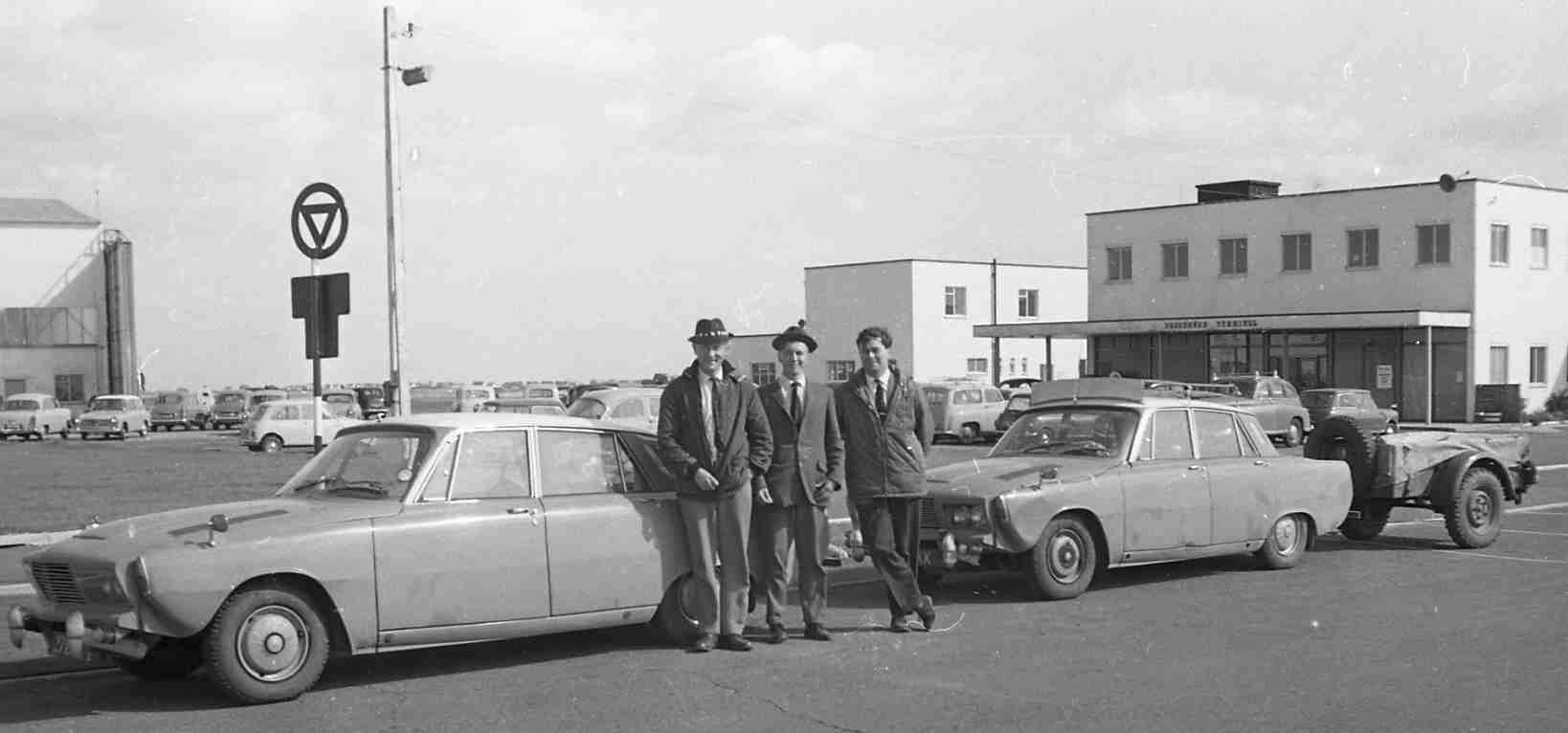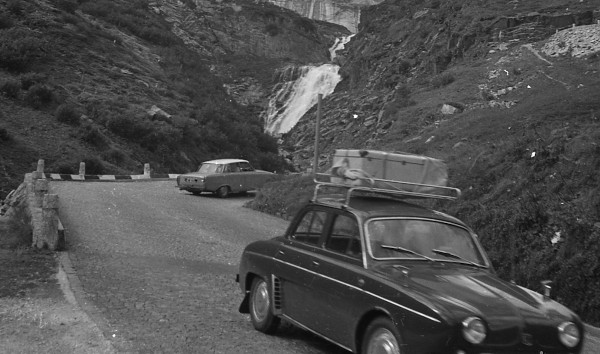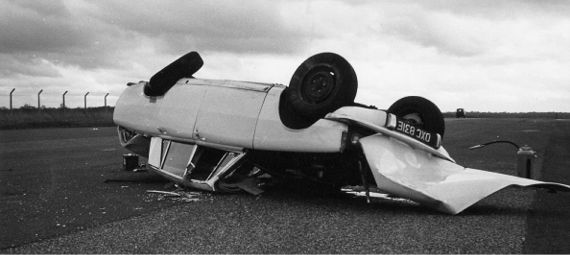Rare Rovers - P7
Sketches in metal
Following the successful launch of the Rover 2000 or P6, as it was known internally, there was a desire to develop the vehicle by offering different engine options. This was something that had been done before with the Rover 75, first of the P4 series of cars. This article recalls some of the options that were considered before the V-8 ex-Buick engine was adopted to produce the Rover 3500 or P6B and to try out new ideas for future designs.
In the original note Rex Marvin refers to 'the 6 cylinder version of the P6 engine'. In retrospect I wonder if that was a typographical error as I have a distinct memory of a 5-cylinder 'P6' that my father, Jim Shaw, brought home one night. At this distance in time I have no recollection at all of any references by my father to the existence of P7 as a name, 'if it looked like a P6 then it was a P6' as far as the family was concerned!
The Rover P7 Experimental Cars
adapted from notes by Rex Marvin, Chief Project Engineer
The Rover P7 experimental cars were one of the many projects being worked on during the mid 60's by
the New Vehicle Projects Department headed by Spen King, exploring new concepts to provide
"bookshelf" solutions to specific design areas which could be "picked off'" when a new car was to be
designed.
It had been recognised by Spen and Peter Wilks during the P6 development that too much had to be
designed from scratch with disastrous effects on the Timing Programme and Product Quality. Gordon
Bashford headed the design team and I ran the development team and we embarked on the creation of a
series of prototypes each having a unique specification.
The following notes are from my memory (I was not an inveterate diary keeper).
P7/l andP7/2
Registration Nos: 17 EXK and 27 EXK

These cars, one manual transmission and the other auto, were the first P6s to be fitted with the 6-cylinder version of the P6 engine and were "workshop" styled. They were used for cooling tests and presented some tough problems to the young engineer Jim Randle, later to become Engineering Director at Jaguar. The lessons learnt from these cars were fed into the design of the styled version of the intended 6-cylinder car. As there was concern about funding of the new engine a number of prototypes were built using a 2.6 litre version of the old i.o.e. engine. These were designated P6/6 but this all came to an end with the purchase of the Manufacturing Rights for the Buick V8, which was to have such an impact on subsequent Rover history.

P7/3 and P7/4
Registration Nos: 37 GYK and 47 GYK
P7/3, auto and P7/4 manual were built with a simulation of the proposed style with a faired-in 4-headlamp scheme behind Perspex covers, which at that time looked attractive. P7/4 was capable of 128 mph and at this time the overall 70mph limit had not been introduced so we had plenty of opportunities to enjoy our work. The 6-cylinder engine, whilst much quieter and smoother than the P6 unit did not compare with the V8, and was eventually cancelled after some high level "debate". P7s 1,2 and 3 were scrapped but No. 4 was sold to Edward Eves, at that time Midland Editor of Autocar. He retained the car for some years before selling it to an enthusiast in North Wales.
P7A
Registration No: Not remembered.
The front suspension of P6, designed to provide an engine bay wide enough for the possible fitment of gas turbine engine, had long been recognised as a severe constraint on road noise refinement and cornering performance through poor wheel camber control. By this time thought was being given to a P5 replacement known as P8 so this further batch of P7s was commenced. P7 was planned before the V8 engine decision was taken; thus it was built with a 6-cylinder engine. The major change was the incorporation of double-wishbone front suspension mounted on a subframe which was isolated from the body by 4 cylindrical interleaved rubber bushes disposed parallel to the vehicle longitudinal axis. Alteration of the position of the inner pivot height of the upper wishbone was possible, thus allowing various roll centre heights to be explored. During subsequent testing the optimum position was determined balancing camber control and steering kickback.
P7/B
Registration No: HXC 21C.
This car was similar to P7/A in chassis specification but incorporated the V8 engine. The handling was greatly improved by the reduced engine weight and the road noise attenuation was much superior to P6/B as was engine refinement.
P7/B was also used as a test bed for various brake and clutch systems. Some surviving records can be found here.
P7/C
Registration No: OXC 831E.
Front suspension and engine installation were as P7/B but the rear suspension was completely new representing the intended design for P8. It incorporated a fixed length de Dion tube, forward of the wheel centre line, pivoted on a complex rubber bearing mounted on the axle extension housing. Constant velocity plunging driveshafts were used and diagonal radius rods completed the location. Early assessments were very encouraging with major improvements in ride, handling and road noise reduction. The usual development programme of spring and damper optimisation, suspension bush rate selection and tyre selection occupied and educated our small team of engineers.
A major challenge arrived one day in the form of a 6B pencil sketch by Spen King of an idea for rear suspension levelling using a single Boge Hydromat identical to that which had just been introduced on the low pivot swing axle Mercedes Benz 300 and was later to be used on Range Rover. Philip Mander managed to decipher the sketch (It was more than our pride was worth to go back to Spen for further clarification) and turn it into manufacturable parts, one of which was always known as the "jawbone of an ass" because of its shape. The system worked well providing ride height correction for increasing payload without adding roll stiffness. The knowledge gained was fed into the Design Office for incorporation in P8. Not all the ideas were successful; permanent magnet bonnet catches were not!
The "in vogue" handling test at the time was to assess the car's response to sudden closing of the throttle when on the cornering limit but making no attempt to correct any subsequent deviations. I had done this test dozens of times in the P6BS on the Lucas Proving Ground at Honiley to select a suitable tyre to eliminate the unwanted oversteer. The Pirelli CN36 proved to be the best choice and enabled us to have the same size all round. To return to P7/C we were comparing tyres using the same test. Perhaps we had done too many laps and the tyres were sticky but the result was an inversion. The two of us in the car thought we had simply rolled through 180 degrees but we actually did three and a half rolls.

(Credit: Denis Chick)
The roof collapsed considerably but Peter Storrie and I managed to crawl out of the front passenger's door window aperture, much to the surprise of the spectators. Peter was unhurt and I only had a small cut in my head and a cracked vertebra, which said a lot about the safety of P6. However, it led to an instruction from Peter Wilks that crash helmets would be worn in future dangerous testing. The car was rebuilt for further testing of power hydraulic systems from Girling and Lockheed.
P7/D
Registration No: KXC 963D. This prototype was based on a P5B and incorporated the combined heater and air conditioning unit proposed by Smiths Industries for P8, as well as the front suspension of the 3 previous P7s. Testing in Rovaniemi, Northern Finland and Italy by Eric Branson highlighted changes needed for P8.
P7/E
Was there one?
P7/F
Registration No: JXC 820D.
Based on a P6B this car was built to test the feasibility of a live axle which was being proposed
for
P10, later to be known as SD1. In order to simulate the target weight for SD1 most of the trim was
removed and the car was nicknamed "The Lightweight Bomber". The rear suspension linkages, spring and
damper positions and layout were a close representation of SD1 design but a Vauxhall Ventora axle
was used. Rigorous testing in the UK and on the Stelvio Pass demonstrated that with adequate wheel
travels the design was viable and SD1 went ahead.
This is my memory of all the P7s that were built. In writing it I have realised that my memory is
less clear that I thought it was so I will not be offended by corrections - it would be good to have
the record straight. As a postscript it is worth recording that the P7 work led to a P8 design which
produced less road noise than a Jaguar XJ6.
(c) Rex Marvin 1996. Reproduced by kind permission of Mrs. June Marvin.